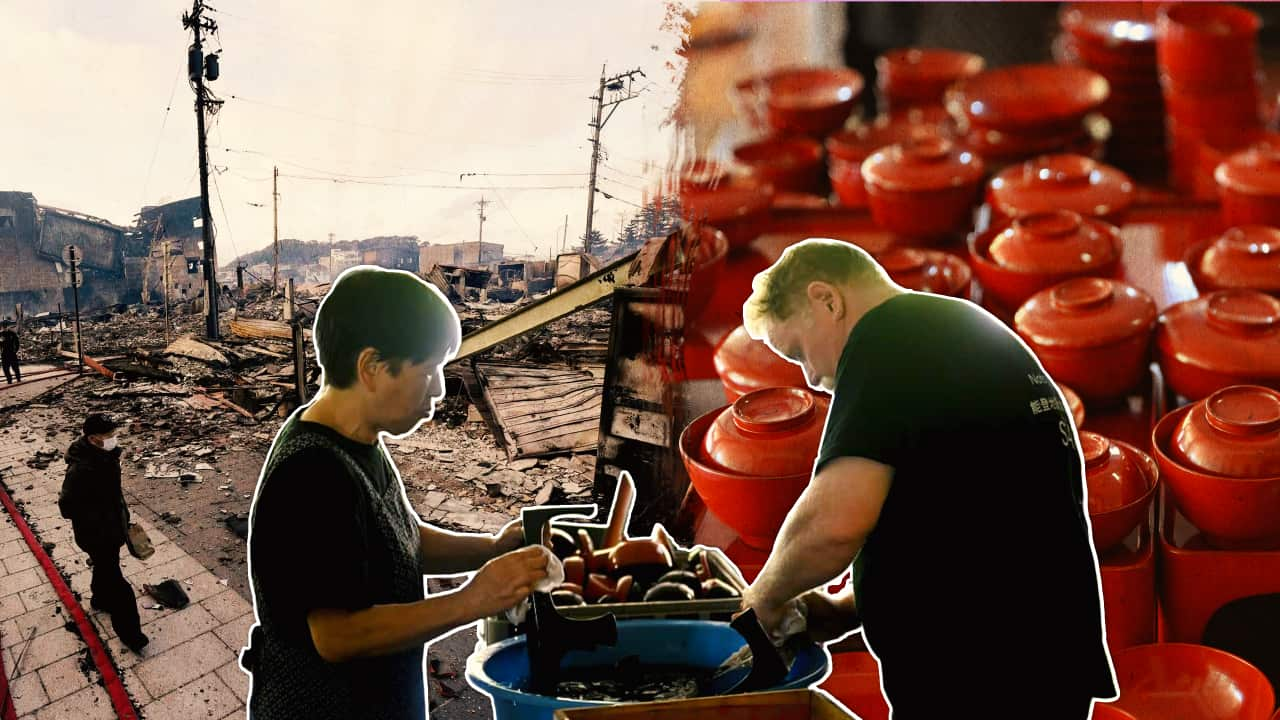Key Points
- An earthquake on New Year’s Day 2024 killed more than 200 people on Japan’s Noto Peninsula.
- One year on, restoration efforts remain slow compounded by heavy recent flooding.
- Benjamin Flatt, an Australian chef who lives in Noto, started an association with his wife that helps preserve the local culture and bring people together.
Located in Ishikawa Prefecture, on the central coast of Honshu Island, the largely rural area has a high ageing rate, with more than half of its population aged 65 or older.

People walk past collapsed buildings following an earthquake in Wajima, Ishikawa prefecture, Japan. A series of powerful earthquakes in western Japan damaged homes, cars and boats. Source: AAP / ñÓìáêíãM/AP
The earthquake highlighted the challenges of managing disaster evacuation and relief efforts in older communities.
It has also had a devastating impact on local lacquerware artisans, with many workshops totally or partially destroyed by the earthquake and subsequent fires.

Wajima lacquerware (Wajima-nuri) from Japan’s Ishikawa prefecture is renowned for its durability and intricate decorations. Credit: Noto Sapo
Wajima, one of the worst affected municipalities, has been renowned for its lacquerware (called Wajima-nuri) production since the late Edo period (1603–1868).
The craft, with its complex and labour-intensive production processes, is recognised as an ‘important intangible cultural property’ by the Japanese government.
Slow restoration
Sally Townsend is Chair of the Australian and New Zealand Chamber of Commerce in Japan (ANZCCJ). She and her staff recently embarked on a tour around the peninsula to observe firsthand the utilisation of a 2 million yen (more than $20,000) donation raised at a charity auction in January 2024.

Restoration efforts on the Noto Peninsula are still progressing slowly, as of September 2024. Credit: Australian and New Zealand Chamber of Commerce in Japan
Though Townsend said she expected the recovery pace to be slow, given the severity of the earthquakes and the difficulty of accessing the area, she was shocked to learn that some places had only just had their electricity reconnected in September.
“Many homes that had collapsed have simply been bulldozed and cleared so you’ll drive down a beautiful little street that’s pocked with empty lots that look likely to remain that way.”
Part of the Noto ‘family’
But by accepting the local ways — their rules, culture, and even how to work — he said it did not take long for people to accept him.
When they said to me, ‘Ben-san, you’ve become local,‘ I felt they were my family.
Benjamin Flatt
Many houses did not have running water and electricity, and were partially destroyed, hampering mobility.

Chikako Funashita (second from left), Benjamin Flatt (third from right) and their staff cook for neighbours after the Noto Peninsula Earthquake that occurred on 1 January 2024. Credit: Supplied
Flatt and Funashita said they received a lot of help from friends and customers from outside the affected area, which allowed them to focus on how to efficiently share relief supplies with neighbours and cook for them.
One month later, the couple founded the Noto Earthquake Area Reconstruction Support Association (Noto Sapo), an incorporated association whose activities include the distribution of donated goods, soup kitchen support, preservation of Wajima lacquerware, efforts to pass on Noto’s preserved and fermented food culture, and gatherings to connect people.
Funashita and Flatt started a “revival market” at the community centre, where local businesses could sell their products with part of the profits used to fund a soup kitchen or tea room for residents to meet and talk with other people.
Crisis of culture
“Wajima lacquerware is a very important part of the history and culture of the region, and each piece takes months to craft. One local craftsman who runs his business with his son, had his workshop almost entirely destroyed in the January 1 earthquakes,” she said.

Among the rescued Wajima lacquerware are items that are 300 years old. Credit: Australian and New Zealand Chamber of Commerce in Japan
After the earthquake, Flatt and Funashita noticed more and more treasured items of lacquerware scattered amid the debris.
“What we have to do now is protect our culture,” Funashita said.

Benjamin Flatt (right) washes Wajima-nuri (lacquerware from Japan’s city of Wajima) that was rescued from a house damaged during the 1 January 2024 earthquake. Credit: Supplied
In their scheme, the owner entrusts Noto Sapo with their lacquerware, and then volunteers clean and restore the heirlooms before packing them for ‘adoption’.
“The newer ones are 50 years old, some older ones are 300 years old. Please accept it as our piece of history,” the Noto Sapo page said.

A Noto Sapo volunteer is cleaning wooden cases of Wajima lacquerware.
Townsend said these efforts are giving residents peace of mind, knowing that their precious heirlooms are being cared for and appreciated by others.
“Sets are given ‘new homes’ for an adoption fee, which then goes back to the original owners. Many of the sets have gone to high-end restaurants in Tokyo who then post images on social media of the lacquerware being used,” she said.
